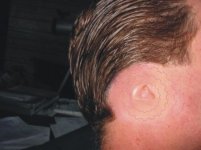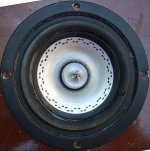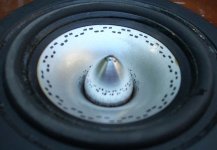The only measurement I know of, that I think actually shows what EnABL is accomplishing, is here.
Enable Tests
The test was performed by John K (here on diy) on an aluminum driver of, I believe, 7 inches diameter. Just the standard generic pattern was used, so an inner and outer ring on the cone only. No gloss coating, just the pattern rings. John also provided other, much more dramatically beneficial cone modification schemes, that addressed things other than what the generic EnABL patterns work on. Those other tests may or may not still be available somewhere. All of them were important, but the only one that shows what is available in the above blink comparison was the EnABL patterned driver.
When you roll your mouse over the CSD plots, look closely at the main resonance nodes, the obvious ones at about 7 khz and 9 kHz. Notice how diffuse the untreated resonance nodes are, as the CSD falls in amplitude. Then notice how articulated the treated resonance nodes are. This, in my opinion, clearly shows how coherent EnABL allows the driver to be. We aren't adding anything, we are removing a daughter node or two, but the real benefit is in the detailed sonic structures that can now arise from the cone.
There are also are a number of tests by George Soon, soongsc, post 172, 174,249,254,278 & 2255 on the original giant thread here,
http://www.diyaudio.com/forums/showthread.php?s=&threadid=100399,
that eventually show the complete dispersal of the main resonance node on a Jordan JX92s with the application of an EnABL pattern to a specific location. Later, I took precise measurements, from a picture provided of the treated driver, and duplicated the pattern in the usual materials. I cannot claim removal as complete as George's was, since I do not have a precision test set up as he does, but the audible benefits of however much change was effected, by my pattern application, were very useful. Audibly removing any hint of shriek, peak or shout from the four drivers on hand.
Now, if you need to argue about the technical merits, test validity, or complete idiocy of claims being made, this is the wrong thread.
Bud
Enable Tests
The test was performed by John K (here on diy) on an aluminum driver of, I believe, 7 inches diameter. Just the standard generic pattern was used, so an inner and outer ring on the cone only. No gloss coating, just the pattern rings. John also provided other, much more dramatically beneficial cone modification schemes, that addressed things other than what the generic EnABL patterns work on. Those other tests may or may not still be available somewhere. All of them were important, but the only one that shows what is available in the above blink comparison was the EnABL patterned driver.
When you roll your mouse over the CSD plots, look closely at the main resonance nodes, the obvious ones at about 7 khz and 9 kHz. Notice how diffuse the untreated resonance nodes are, as the CSD falls in amplitude. Then notice how articulated the treated resonance nodes are. This, in my opinion, clearly shows how coherent EnABL allows the driver to be. We aren't adding anything, we are removing a daughter node or two, but the real benefit is in the detailed sonic structures that can now arise from the cone.
There are also are a number of tests by George Soon, soongsc, post 172, 174,249,254,278 & 2255 on the original giant thread here,
http://www.diyaudio.com/forums/showthread.php?s=&threadid=100399,
that eventually show the complete dispersal of the main resonance node on a Jordan JX92s with the application of an EnABL pattern to a specific location. Later, I took precise measurements, from a picture provided of the treated driver, and duplicated the pattern in the usual materials. I cannot claim removal as complete as George's was, since I do not have a precision test set up as he does, but the audible benefits of however much change was effected, by my pattern application, were very useful. Audibly removing any hint of shriek, peak or shout from the four drivers on hand.
Now, if you need to argue about the technical merits, test validity, or complete idiocy of claims being made, this is the wrong thread.
Bud
Last edited:
Here ya go Wayne. There is a fourth pattern across the bottom of the case, that matches the one on the top. These will be invisible from a foot away, if done in the clear flat paint that comes in the kit. The horn and some of the cone patterns will be visible from farther away.
The more specifically placed patterns will be in slightly different places and there will likely be more of them, on both the cone / dome and horn. There might be a need for one or more sub patterns on the face of the cabinet.
All of these altered pattern placements are to be determined.
Bud
The more specifically placed patterns will be in slightly different places and there will likely be more of them, on both the cone / dome and horn. There might be a need for one or more sub patterns on the face of the cabinet.
All of these altered pattern placements are to be determined.
Bud
Attachments
Thank you, Bud.
I will be glad to post my results when I receive the kit from Ed and start work on the Advents.
I will be glad to post my results when I receive the kit from Ed and start work on the Advents.
Thanks for the measurements Bud. I've been looking for those for a while. Soongsc's pattern looks really good on the Jordans.
Thanks again,
Dan
Thanks again,
Dan
I thought those were bullets to shoot the non-believers.
Unless the EnABL pattern allows them too travel trougth ADSL lines, i guess even those off us who thinks this is just Voodo mumbo jumbo can feel pretty safe from those bullets
The only measurement I know of, that I think actually shows what EnABL is accomplishing, is here.
Enable Tests
The test was performed by John K (here on diy) on an aluminum driver of, I believe, 7 inches diameter. Just the standard generic pattern was used, so an inner and outer ring on the cone only. No gloss coating, just the pattern rings. John also provided other, much more dramatically beneficial cone modification schemes, that addressed things other than what the generic EnABL patterns work on.
Bud
As a scientist and researcher all my life, and the person to presented the data in question, I find it interesting how the promoter of an idea will claim arbirtary data shows a beneficial result when at best all that can be said about the data is that the effect can be categorized as difference. In this case the promoter never heard the driver used in the test, before or after treatment, and is hardly in a position to pass judgment on whether the difference between the treated and untreated driver is beneficial or detrimental, or even nill.
..
when at best all that can be said about the data is that the effect can be categorized as difference...
.
John would you mid to point me where you outlined measurement conditions and what treatment you applied - its not exactly been enABL was it ?
Possibly there *can* be said a word or two regarding the "categorization of the difference" ..
Michael
Last edited:
Hi Michael,
I don't know that the original posts will help, but here is where to start reading.
http://www.diyaudio.com/forums/multi-way/100399-enabl-processes-201.html#post1415087
And here is a summation of answers, though there are other posts in the vicinity that relate to John K's tests of surface effects.
http://www.diyaudio.com/forums/multi-way/100399-enabl-processes-205.html#post1416935
I don't know that the original posts will help, but here is where to start reading.
http://www.diyaudio.com/forums/multi-way/100399-enabl-processes-201.html#post1415087
And here is a summation of answers, though there are other posts in the vicinity that relate to John K's tests of surface effects.
http://www.diyaudio.com/forums/multi-way/100399-enabl-processes-205.html#post1416935
Thaks Bud
I have not found the right answers (sadly lots of stuff deleted), maybe you, John or someone else can help again.
- this are measurements of John, right ?
- is it the metal cone mentioned ?
- is it enABL pattern versus non-treeted or his own patterns versus non treated ?
- what material is the tratment: acrylc or the bluetag stuff mentioned ?
Apart form this specific measurements - I've read that enABL started out with Walsh.
Interestingly I have not seen someone in the many posts I read to make the connection to Manger soundwise - though I would have expected the sonic signature of enABL to go in that direction (merly of what usually is reported - have not heard either myself) ?
Have I overlooked that or am I thinking in the wrong direction ?
Michael
I have not found the right answers (sadly lots of stuff deleted), maybe you, John or someone else can help again.
- this are measurements of John, right ?
- is it the metal cone mentioned ?
- is it enABL pattern versus non-treeted or his own patterns versus non treated ?
- what material is the tratment: acrylc or the bluetag stuff mentioned ?
Apart form this specific measurements - I've read that enABL started out with Walsh.
Interestingly I have not seen someone in the many posts I read to make the connection to Manger soundwise - though I would have expected the sonic signature of enABL to go in that direction (merly of what usually is reported - have not heard either myself) ?
Have I overlooked that or am I thinking in the wrong direction ?
Michael
Last edited:
Hi Michael,
The blink comparison is John K's test of a metal cone speaker. He applied the standard EnABL pattern, a ring set at voice coil or dust cap and cone and another set out just before the surround. He did advise me that he was as careful and correct as he could be in the application. Since John is careful and correct in everything else he has presented I am satisfied that the test is repeatable. My memory of his comments leads me to believe the materials used for the EnABL patterns were acrylic paint. However he provided no pictures of the DUT and my memory is at best faulty. I also do not know what driver was used ie. mfg, type of metal, though aluminum seems likely, or any other details.
For further investigation look in the same thread for Sonngsc's tests of a Jordan metal cone driver. His results came from applying toothpaste in an EnABL pattern. Some of the results are surprising, they show an obvious change in phase above the first breakup point without a comparable change in FR, as more ring sets are added. This data was found to be unacceptable to many who hold that drivers are minimum phase devices.
I am usually confused by this, as the point in support of this that has typically been made, is that minimum phase type circuit elements do indeed make minimum phase alterations to the entire FR of a driver. That this, by logical inference, does mean that all drivers are minimum phase devices, regardless of raw phase plots to the contrary. And yet, here is a post signal process, making changes in phase that show non minimum phase behavior, without altering the FR.
In any event here are the relevant pages of a number of tests by George Soon, soongsc, post 172, 174, 249, 254, 278 & 2255 on the original giant thread here, EnABL Processes - diyAudio[/url
I have also attached a text that contains most of the threads, other than recent scattered posts, for EnABL. Not much in the way of technical information, but quite a bit of ad hoc, personal experience .
I think the connection can be made to Manger drivers. After all, the disabling of those elements that corrupt the emission of a correct wave form must all have the same sonic character. That of the original source.
The blink comparison is John K's test of a metal cone speaker. He applied the standard EnABL pattern, a ring set at voice coil or dust cap and cone and another set out just before the surround. He did advise me that he was as careful and correct as he could be in the application. Since John is careful and correct in everything else he has presented I am satisfied that the test is repeatable. My memory of his comments leads me to believe the materials used for the EnABL patterns were acrylic paint. However he provided no pictures of the DUT and my memory is at best faulty. I also do not know what driver was used ie. mfg, type of metal, though aluminum seems likely, or any other details.
For further investigation look in the same thread for Sonngsc's tests of a Jordan metal cone driver. His results came from applying toothpaste in an EnABL pattern. Some of the results are surprising, they show an obvious change in phase above the first breakup point without a comparable change in FR, as more ring sets are added. This data was found to be unacceptable to many who hold that drivers are minimum phase devices.
I am usually confused by this, as the point in support of this that has typically been made, is that minimum phase type circuit elements do indeed make minimum phase alterations to the entire FR of a driver. That this, by logical inference, does mean that all drivers are minimum phase devices, regardless of raw phase plots to the contrary. And yet, here is a post signal process, making changes in phase that show non minimum phase behavior, without altering the FR.
In any event here are the relevant pages of a number of tests by George Soon, soongsc, post 172, 174, 249, 254, 278 & 2255 on the original giant thread here, EnABL Processes - diyAudio[/url
I have also attached a text that contains most of the threads, other than recent scattered posts, for EnABL. Not much in the way of technical information, but quite a bit of ad hoc, personal experience .
I think the connection can be made to Manger drivers. After all, the disabling of those elements that corrupt the emission of a correct wave form must all have the same sonic character. That of the original source.
Attachments
Last edited:
Thanks Cal. I was about to ask that the deleted material be moved to the technical thread. Is this still possible, I think it is likely ti get quite interesting.
Bud
Bud
Posts concerning technical aspects deleted along with collateral damage due to referencing.
Don't arm the gardeners that massively !

LOL
😉
Last edited:
Posts concerning technical aspects deleted along with collateral damage due to referencing.
Hi,
Well that makes it easy, the last thing wanted is an outbreak of sensible engineering.
😉/Sreten.
To get the ball rolling I would like to witness the following test:
8 drivers. 4 EnABLed, 4 not, 4 boxes.
First listen to all four of the untreated in an AB test to confirm there is little or no difference among them, hopefully.
Then swap out 2 of the 4 and replace them with 2 of the EnABLed and do a comparison.
Finally all 4 EnABLed to listen side by side again. I think that would give me the greatest satisfaction in making my decision and offering comments. At this point all I have is an AB test with one set of drivers with planet10 treatment and one set with planet10 treatment and EnaABLed so my opinion cannot be considered very accurate at this point but my impression is that EnABLing the driver seems to remove the "cloud". It seems to sound less like a speaker that the non-treated driver.
My 10 cents.
Back to the original intent.
I have 28 Tang Band W3-871 drivers that will be used in a 7.1 surround system. I am planning to go the EnAbl route as well as treating the baskets with the "planet10" methods. I gladly volunteer these drivers for this kind of testing but as I am very new to this all would need some guidance.
I believe that Dave has (or had) a set of EnAbl'd W3-871 so maybe I could get a photo of where to place the magic marks. I'm even willing to head out to BC to get someone hands on training and let Cal do the listening.
I believe that Dave has (or had) a set of EnAbl'd W3-871 so maybe I could get a photo of where to place the magic marks. I'm even willing to head out to BC to get someone hands on training and let Cal do the listening.
2 sets. Still have. (slowly) working on new boxes for a pair of them.
dave
- Home
- Loudspeakers
- Multi-Way
- EnABL - Listening impressions & techniques



